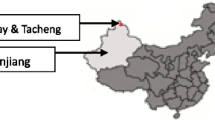Abstract
Aim
To report on the distribution of eye diseases, aetiologies of severe visual impairment/blindness (SVI/BL) and unmet eye care needs of the Syrian refugee population and the Lebanese host community.
Methods
This retrospective study analysed the data of patients that were examined during the Ayounkon project –an eye health care project offering medical and surgical treatment for Syrian refugees and Lebanese host community in the Bekaa Valley in Lebanon. The project took place in three different primary health care centres and involved cooperation between several NGOs and ophthalmologists working on a voluntary basis. Data was analysed for distribution of eye diseases and aetiologies responsible for monocular and binocular SVI/BL.
Results
A total of 2067 patients were included, 677 were children < 18 years. The most frequent pathologies were ocular allergy (10%), and cataract (7.4%). 158 patients (7.6%) were referred for surgery. Glasses were prescribed for 1103 patients (53.4%), of whom 242 (21.9%) were children of school age.
SVI/BL was found in 276 patients (13%). The condition was bilateral in 116 patients (42%). SVI/BL was significantly more frequent in the Syrian population than in the Lebanese (186 patients, 14.8% versus 86 patients, 11.3%; p = 0.04). The main causes for SVI/BL were cataract, keratoconus/corneal decompensation and amblyopia.
Conclusion
The Syrian refugee population and the Lebanese host community have a high prevalence of ophthalmic pathologies and SVI/BL. Visual impairment is more prevalent in the refugee population. Our findings underscore the importance of targeted interventions and access to eye care services for these populations.
Similar content being viewed by others
References
United Nations High Commissioner for Refugees (2023) Global trends. Forced displacement in 2021. https://www.unhcr.org/62a9d1494/global-trends-report-2021. Accessed 18 Mar 2023
Lebanon–inter agency–social stability (2023) End of year sector dashboard. https://data.unhcr.org/en/documents/details/99569. Accessed 18 Mar 2023
Syrian regional refugee response in Lebanon (2023) https://data.unhcr.org/en/situations/syria/location/71. Accessed 18 Mar 2023
Gelberg L, Andersen RM, Leake BD (2000) The behavioral model for vulnerable populations: application to medical care use and outcomes for homeless people. Health Serv Res 34:1273–1302
Spiegel PB, Cheaib JG, Aziz SA et al (2020) Cancer in Syrian refugees in Jordan and Lebanon between 2015 and 2017. Lancet Oncol 21:e280–e291. https://doi.org/10.1016/S1470-2045(20)30160-1
Bin Yameen TA, Abadeh A, Lichter M (2019) Visual impairment and unmet eye care needs among a Syrian pediatric refugee population in a Canadian city. Can J Ophthalmol 54:668–673. https://doi.org/10.1016/j.jcjo.2019.03.009
Vitale S, Cotch MF, Sperduto RD (2006) Prevalence of visual impairment in the United States. JAMA 295:2158–2163. https://doi.org/10.1001/jama.295.18.2158
Gelaw Y, Abateneh A (2014) Ocular morbidity among refugees in Southwest Ethiopia. Ethiop J Health Sci 24:227–234
Vincent J, Netek S, Green F, Yone L (2017) Screening and correcting refractive error in refugee and migrant school children on the Thai–Burma border. In: Rangsit University international optometry conference, Bangkok, April 2017
WHO (2016) ICD-10 version: 2016. https://icd.who.int/browse10/2016/en-/H53-H54
Hu B, Liu Z, Zhao J et al (2022) The global prevalence of amblyopia in children: a systematic review and meta-analysis. Front Pediatr 10:819998. https://doi.org/10.3389/fped.2022.819998
Awan HR, Ihsan T (1998) Prevalence of visual impairment and eye diseases in Afghan refugees in Pakistan. EMHJ-East Mediterr Health J 4(3):560–566
Al-Rubeaan K, Abu El-Asrar AM, Youssef AM et al (2015) Diabetic retinopathy and its risk factors in a society with a type 2 diabetes epidemic: a Saudi national diabetes registry-based study. Acta Ophthalmol (Copenh) 93:e140-147. https://doi.org/10.1111/aos.12532
Yau JWY, Rogers SL, Kawasaki R et al (2012) Global prevalence and major risk factors of diabetic retinopathy. Diabetes Care 35:556–564. https://doi.org/10.2337/dc11-1909
Teo ZL, Tham Y-C, Yu M et al (2021) Global prevalence of diabetic retinopathy and projection of burden through 2045: systematic review and meta-analysis. Ophthalmology 128:1580–1591. https://doi.org/10.1016/j.ophtha.2021.04.027
Thylefors B (1992) Epidemiological patterns of ocular trauma. Aust N Z J Ophthalmol 20:95–98. https://doi.org/10.1111/j.1442-9071.1992.tb00718.x
El-Khoury S, Strittmatter S, Tuyisabe T et al (2023) Distribution and causes of blindness and severe visual impairment in children at a tertiary referral centre in Rwanda. Br J Ophthalmol 108:321522. https://doi.org/10.1136/bjo-2022-321522
Jackson H (1996) Bilateral blindness due to trauma in Cambodia. Eye Lond Engl 10(4):517–520. https://doi.org/10.1038/eye.1996.113
Treister G (1969) Ocular casualties in the six-day war. Am J Ophthalmol 68:669–675. https://doi.org/10.1016/0002-9394(69)91251-3
El-Khoury S, Abdelmassih Y, Hamade A et al (2016) Pediatric keratoconus in a tertiary referral center: incidence, presentation, risk factors, and treatment. J Refract Surg Thorofare NJ 32:534–541. https://doi.org/10.3928/1081597X-20160513-01
Funding
The Ayounkon projet was funded the United Nations Office for the Coordination of Humanitarian Affairs (UN-OCHA) as an initiative to support eye health.
Author information
Authors and Affiliations
Contributions
YA, MM and SE wrote the manuscript, MI and GS collected the data, MC prepared the table, YA reviewed the data and did the statistics. All authors reviewed the manuscript.
Corresponding author
Ethics declarations
Conflict of interests
No conflict of interest for any of the authors.
Additional information
Publisher's Note
Springer Nature remains neutral with regard to jurisdictional claims in published maps and institutional affiliations.
Rights and permissions
Springer Nature or its licensor (e.g. a society or other partner) holds exclusive rights to this article under a publishing agreement with the author(s) or other rightsholder(s); author self-archiving of the accepted manuscript version of this article is solely governed by the terms of such publishing agreement and applicable law.
About this article
Cite this article
Abdelmassih, Y., Makhoul, M., Issa, M. et al. The Ayounkon project: visual impairment, eye diseases and unmet eye care needs in the Syrian refugee population and the hosting community in Lebanon. Int Ophthalmol 44, 42 (2024). https://doi.org/10.1007/s10792-024-02930-3
Received:
Accepted:
Published:
DOI: https://doi.org/10.1007/s10792-024-02930-3




